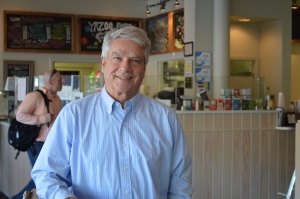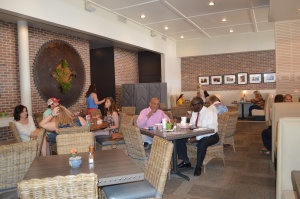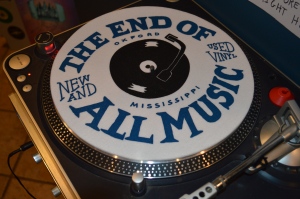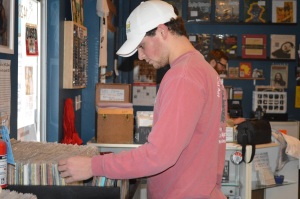
Tourists relax outside of Yazoo Pass during the Juke Joint Festival in Clarksdale, Mississippi. The restaurant opened in 2011 and has grown each year thanks to locals and, of course, the Juke Joint Festival which brings in tremendous sales for the weekend. Photo by Randall Haley.
Clarksdale’s 12th annual Juke Joint Festival hit the streets on April 11. Because of the numerous visitors the festival brought in to the small Delta town, stores and restaurants busily prepared months in advance for the big day.
Although the Juke Joint Festival was scheduled to take place on one day, Saturday, visitors bring new business to the town over the entire weekend, generally starting on Thursday.
Yazoo Pass, a bistro and bakery in the heart of downtown Clarksdale, was a big hit for the tourists. Owners John Cocke and Meri Tenhet said they didn’t do enough to prepare for this year’s festival.
“We triple our sales during Juke Joint,” Cocke said, comparing the Saturday of Juke Joint sales to their busiest day of the week, Friday.

John Cocke, owner of Yazoo Pass, poses in front of the counter of his restaurant. Cocke’s main occupation is a lawyer, but he is fascinated with running restaurants, and thus owns Yazoo Pass as a hobby. Photo by Randall Haley.
Yazoo Pass opened in 2011 and has grown in sales, as well as menu items, every year.
“When I first started this, I kind of pictured it as mostly pastries and just small lunch,” Tenhet said. “And we are going into our fourth year of business, and we run six days a week, 14 hours a day, breakfast, lunch, and dinner. So we’ve turned into much more than I ever imagined we would.”
According to Tenhet, in years past when the Juke Joint Festival took place, everything ran smoothly. This year, however, was far more chaotic.
“This year was really different from many other years because I got sick,” Tenhet said. “I had to have an emergency appendectomy the week of Juke Joint. So we had a lot of crashes this year that we wouldn’t normally have.”
Tenhet said the staff handled the “crashes” the best they could, but it was hard not having her there to tell them how much food to prep and what to prep.
“After three days of intense business, which is about three times what we would normally do in a day… after a while with no leadership, things tend to break apart a little bit,” Tenhet said.
Although chaotic, owners Tenhet and Cocke still look forward to the festival each year.
“I wish we had two or three juke joints during the year,” Tenhet said. “It really kind of helps us get over a little plateau, usually, that we can’t seem to get over without it because we’re in such a small town in the Delta. So we depend on the Juke Joint.”
Cocke says that Yazoo Pass is a “good little hub” for Clarksdale.
“It’s hard to make money here, and I can’t tell you that we’re really making money, but we’re going to hang in here for the long haul, and we think it’s going to be well,” Cocke said. “It’s important for the city.”
Cocke and Tenhet said that they feel their restaurant was such a big hit during the Juke Joint because they have things to offer that no other restaurant in town does, which is a hard task considering there are many restaurants distinctly unique to Clarksdale.
“Just about everything we serve in there is homemade,” Tenhet said. “There are very few things that we actually purchase that we don’t turn into something else and make our own. So that’s huge in a small town.“
Although they have a different menu for each meal, Yazoo Pass serves a full hot breakfast and lunch in addition to having a fresh food salad bar everyday. They also have frozen yogurt and coffee all day long. At night, the lights go down and they serve steaks, seafood, and pastas. Tenhet says they serve “anything you can imagine.”
The restaurant also has a full bar for visitors to enjoy.
“Last year we got our liquor license,” Tenhet said. “That has made a tremendous difference in our bottom line, and hopefully that will continue to help.”
John Cocke said that Charles Langford of Clarksdale is one customer who often comes in for a “grand slam,” the term Cocke gave when people come in for all three meals in one day.
“It is absolutely fantastic,” Langford said. “It is definitely my favorite restaurant in town (because of) the quality of the food and the service of the people, the friendliness of the people. I come in at least five times a week.”
Cocke and Tenhet are pleased with the feedback they receive from both locals and tourists.

Customers enjoy a meal at Yazoo Pass during the annual Juke Joint Festival in Clarksdale, Mississippi. Photo by Randall Haley.
“It’s a great feeling to know that we have really become a spot in Clarksdale,” Tenhet said. “I think it’s just a bright spot that draws all walks of life in it: every age, every race, everybody in town. It seems to be a place that young or old, black or white, people have embraced and that in itself makes me happy, even if we weren’t successful in making it on our bottom line because I think we’ve kind of been a shot in the arm to Clarksdale just from that aspect of it.”
Find out more of what customers are saying by checking out the Storify link here.




